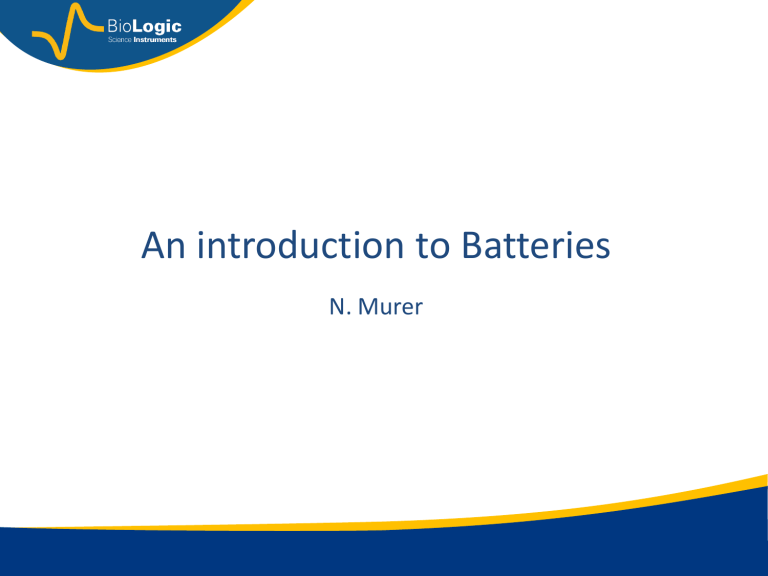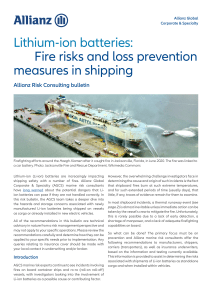
An introduction to Batteries N. Murer Outline 1. Definition and principles 2. Technology 1. Characteristics Outline 1. Definition and principles 2. Technology 1. Characteristics Definition An electrical battery is one or more electrochemical cells that convert stored chemical energy into electrical energy (= current). Primary batteries : cannot be recharged. Secondary batteries : rechargeable batteries that involve reversible reactions (backward and forward) Example of a Li-ion battery How it works 1. Initial state (charged) : Ecell = EOC + M M M M Electrolyte Ecell = Cell voltage = potential difference between the positive electrode and the negative electrode. Example of a Li-ion battery How it works 2. Discharge : Ecell < EOC (charged) (Spontaneous reactions) e- + M M+ M M Electrolyte Cathode/Reduction (Insertion) Anode/Oxidation (Desinsertion) Example of a Li-ion battery How it works 3. Charge : Ecell > EOC (discharged) (Forced reactions) e- + M M M M+ Electrolyte Anode/Oxidation (Desinsertion) Cathode/Reduction (Re-Insertion) Outline 1. Definition and principles 2. Technology 3. Characteristics Technology Various materials are used for the positive and negative electrodes and the electrolyte • Lead acid batteries (PbO2-Pb) • Alkaline batteries (Ni-MH and Ni-Cd) • Lithium-ion batteries (LiCoO2-, LiMn2O4-,LiFePO4-C6) • Lithium Metal Polymer, Lithium-Air, … Technology Name Lead Acid Initial Charged State + - + - Electrolyte PbO2 Pb PbSO4 PbSO4 H2SO4 Nickel Cadmium NiO(OH) Nickel-Metal NiO(OH) Hydride Li1-xCoO2 Li-ion Li1-xFePO4 Li-Metal After discharge Li Cd Main application Automobile starter, PV Ni(OH)2 Cd(OH)2 MH Ni(OH)2 M LixC6 LiCoO2 C6 LixC6 LiFePO4 C6 LixV3O8 Li V2O5 KOH LiPF6 in organic solvent Polymer Electronics Electronics, transportation Technology Lithium batteries represent now the largest share of the market Source : www.umicore.com Outline 1. Definition and principles 2. Technology 3. Characteristics Characteristics Nominal Potential constant potential value of the battery during the discharge in V One cell voltage : Pb = 2 V, Ni-MH = 1.2 V, Li-ion = 3.6 V at constant current Deep discharge or deep charge can lead to potentially dangerous unwanted nonreversible reactions. Ex : H2 production for Ni-Cd battery. Characteristics Capacity electrical charge that can be stored in a reversible way in A.h 1 mol of electrons (6.1023 e-) = 1 Faraday = 96 500 C = 26.81 A.h Energy = Voltage x Capacity in W.h or V.A.h Power = Voltage x Current in W Discharge rate (or charge): current discharge value (galvanostatic mode) expressed as a function of the theoretical capacity. C/n cycling rate: C (theoretical capacity)/n (number of hours). Capacity, Energy and Power are usually expressed by unit of mass or volume for comparison purpose. Characteristics Stack : several batteries in series or parallel Series 1 I + E1 2 - + E2 3 - + 4 - E3 + E4 - - - - - 2 3 4 Parallel 1 Estack = E1 + E2 + E3 + E4 Istack = I1 = I2 = I3 = I4 (same current in all four elements) + + Estack = E1 = E2 = E3 = E4 Istack = I1+ I2 + I3 + I4 + + Estack Load Istack Comparison Battery type Leadacid Ni-MH Ni-Cd Li-ion Rechargeable alkaline Nominal Potential per cell (V) 2 1.2 1.2 3.6 1.5 Cheap Higher capacity than NiCd Less sensitive than NiCd to overcharging, memory effect and deep unloading Rather cheap High currents allowed Highest capacity High capacity (ca. 2 times higher than Ni-MH) Heavy More expensive than NiCd Toxic Memory effect Degrades when overcharged Unusable after too deep unloading Expensive Capacity decreases, even when not used Explosion risk at overheating, over-voltage or polarity reversal Capacity reduced after each cycle (e.g. 50% after 15 cycles) Advantages Drawbacks Thank you for your attention



